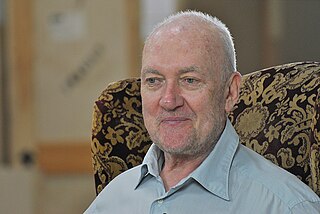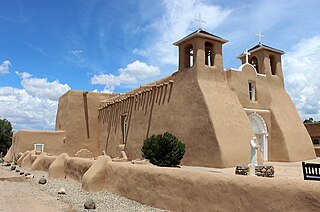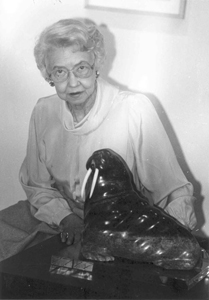Related Research Articles

Taos is a town in Taos County, in the north-central region of New Mexico in the Sangre de Cristo Mountains. Initially founded in 1615, it was intermittently occupied until its formal establishment in 1795 by Nuevo México Governor Fernando Chacón to act as fortified plaza and trading outpost for the neighboring Native American Taos Pueblo and Hispano communities, including Ranchos de Taos, Cañon, Taos Canyon, Ranchitos, El Prado, and Arroyo Seco. The town was incorporated in 1934. As of the 2021, its population was 6,567.

The Taos art colony was an art colony founded in Taos, New Mexico, by artists attracted by the culture of the Taos Pueblo and northern New Mexico. The history of Hispanic craftsmanship in furniture, tin work, and other mediums also played a role in creating a multicultural tradition of art in the area.

Oscar Edmund Berninghaus was an American artist and a founding member of the Taos Society of Artists. He is best known for his paintings of Native Americans, New Mexico and the American Southwest. His son, Charles Berninghaus (1905–1988), was also a Taos artist.

Art colonies are organic congregations of artists in towns, villages and rural areas, who are often drawn to areas of natural beauty, the prior existence of other artists, art schools there, or a lower cost of living. They are typically mission-driven planned communities, which administer a formal process for awarding artist residencies. A typical mission might include providing artists with the time, space, and support to create, fostering community among artists, and providing arts education, including lectures and workshops.

Agnes Bernice Martin was an American abstract painter known for her minimalist style and abstract expressionism. Born in Canada, she moved to the United States in 1931, where she pursued higher education and became a U.S. citizen in 1950. Martin's artistic journey began in New York City, where she immersed herself in modern art and developed a deep interest in abstraction. Despite often being labeled a minimalist, she identified more with abstract expressionism. Her work has been defined as an "essay in discretion, inwardness and silence."

Sean Scully is an Irish-born American-based artist working as a painter, printmaker, sculptor and photographer. His work is held in museum collections worldwide and he has twice been named a Turner Prize nominee. Moving from London to New York in 1975, Scully helped lead the transition from Minimalism to Emotional abstraction in painting, abandoning the reduced vocabulary of Minimalism in favor of a return to metaphor and spirituality in art.

The Amon Carter Museum of American Art is located in Fort Worth, Texas, in the city's cultural district. The museum's permanent collection features paintings, photography, sculpture, and works on paper by leading artists working in the United States and its North American territories in the nineteenth and twentieth centuries. The greatest concentration of works falls into the period from the 1820s through the 1940s. Photographs, prints, and other works on paper produced up to the present day are also an area of strength in the museum's holdings.

San Francisco de Asís Mission Church is a historic and architecturally significant building on the main plaza of Ranchos de Taos, New Mexico. Originally the center of a small Mexican and Indian 18th Century agricultural community. Built between 1772 and 1816 replacing an earlier church in that location. New Mexico was then part of the Vice-Royalty of New Spain. It is a fine example of a New Mexico Spanish Colonial Church, and is a popular subject for artists. It was designated a National Historic Landmark in 1970. It is a parish church of the Roman Catholic Archdiocese of Santa Fe.
James W. Jack Boynton was an American artist.

William (Kross) Greiner in New Orleans, Louisiana, is an American photographer and multi-media artist living in Santa Fe, NM.
The Fort Worth Circle was a progressive art colony in Fort Worth, Texas. The colony was active during the 1940s and much of the 1950s and formed around younger artists, most of them native Texans under-30, who embraced themes not traditionally seen in Texas art up to that time. Through exhibitions and modest publicity these artists built statewide reputations during and after World War II as proponents of modern art. Social compatibility and shared affinities for modern art and classical music provided common ground among members of the circle and contributed to the group's cohesion. Within the circle's original membership, male and female artists were almost equally represented.

Veronica Helfensteller (1910–1964) was an American painter and printmaker, who was a member of the Fort Worth Circle, a group of artists in Fort Worth, Texas, active in the 1940 and 1950s.
Bror Alexander Utter was a painter, printmaker, and art teacher who lived and worked his entire life in Fort Worth, Texas, but his art achieved national recognition. He worked in an array of styles ranging from landscapes influenced by Regionalism, still lifes, architectural scenes, and figurative works inspired by the theater to modernist abstractions. He was a prominent member of the Fort Worth Circle.
Robert Ray was an American artist, active in the middle to late twentieth century.

Blanche McVeigh was an American printmaker, founder of the Fort Worth School of Fine Arts and Fort Worth Artists Guild, and art educator in Fort Worth, Texas. Known for her mastery of the aquatint medium, McVeigh’s leadership in art education influenced a generation of local artists, particularly members of the group known as the Fort Worth Circle. Her work is represented in several national collections as well as local and private collections.

Electra Carlin was an American art dealer and gallery owner in Fort Worth, Texas. She operated Fort Worth's longest-running private art gallery, which was also the first in the area founded and operated by women.

The Old Jail Art Center (OJAC) is an art and regional history museum in Albany, Texas. It is housed in a former jail that was completed in 1878. After being replaced by a new jail in 1929, the old jail building was saved from demolition by local author and playwright Robert E. Nail Jr. in 1940. In 1980, the OJAC was established in the building by his nephew, local author and former television producer Reilly Nail, and Reilly's cousin, artist Bill Bomar.
Juanita Jaramillo Lavadie is a contemporary weaver, textile scholar and muralist based in New Mexico. Her art is centered on the acequia system in Taos County, Northern, New Mexico and is influenced by traditional Hispano and Indigenous cultures. Her work primarily focuses on water rights in Taos County.
Charles Truett Williams was considered one of the first significant modern sculptors in Texas. Active in the mid-twentieth century, the Fort Worth-based artist became known for his inventive, abstracted sculptures, steering away from traditional, life-like renderings then popular in Texas. His mastery spanned across a multitude of media including wood, stone, sheet copper, cast bronze, steel, iron, and found objects.
William Kelly Fearing was an American visual artist who was termed, in his time, a “magical realist” and “Romantic surrealist”. He was a member of the Fort Worth Circle, a cohort of artists often credited with bringing modern art to Texas and the firsts to steer away from the then dominating regional aesthetic. His spiritual themes spanned across multiple styles including abstract, impressionism, and surrealism.
References
- ↑ Dike, David. "Bill Bomar". daviddike.com. David Dike Fine Art. Retrieved 15 October 2015.
- ↑ Wang, Lin (5 March 2013). "The Artist Behind the Collection — Bill Bomar and the Old Jail Art Center". urbanartantiques.com. Urban Art and Antiques. Retrieved 15 October 2015.